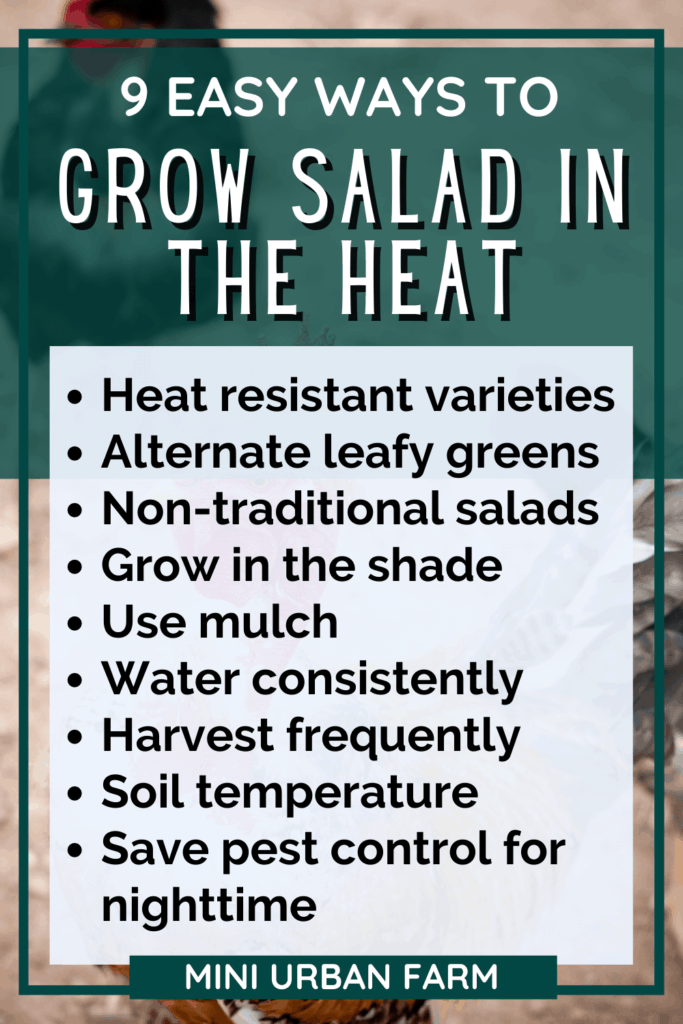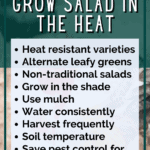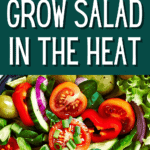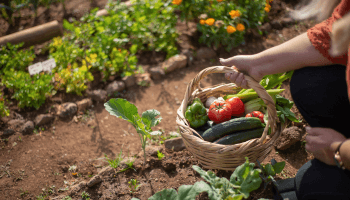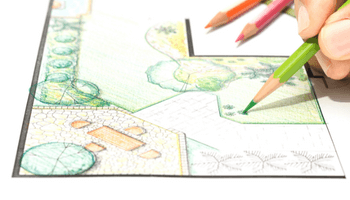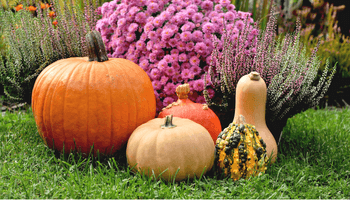Growing salad greens used to seem like a cool-weather only activity here in Central Florida where it gets up into the 100s on any typical summer day. And most traditional salad greens do tend to wilt in this summer heat, making it impossible to enjoy a nice summer salad! But after tons of research and lots of experimentation in the garden, I’ve put together my best tips for growing salad in the summer heat!
Tips for Growing Salad In the Summer:
- Choose heat resistant varieties
- Choose alternate leafy greens
- Grow non-traditional salads
- Grow in the shade
- Use mulch
- Water consistently
- Harvest frequently
- Soil temperature for germination
- Save pest control for nighttime
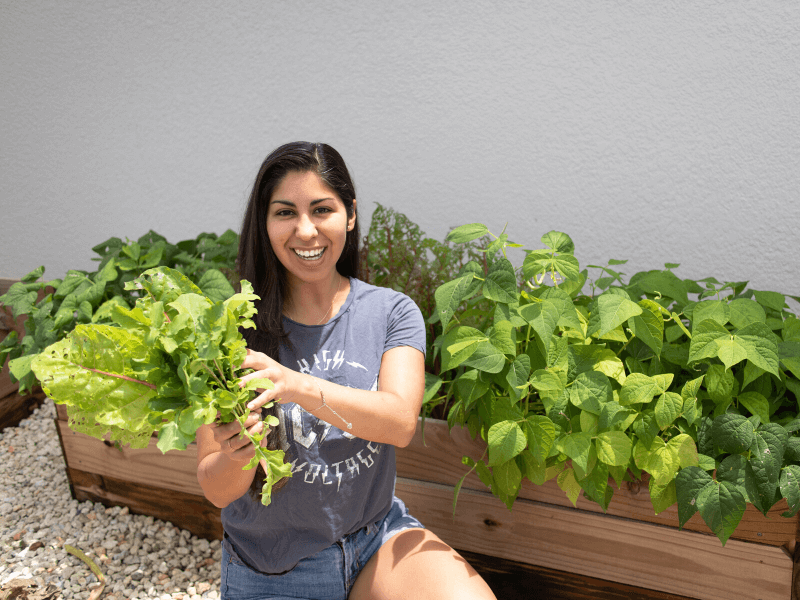
Disclosure: This post may contain affiliate links. If you purchase a product through one of our affiliate links we make a small commission from the sale at no extra cost to our readers.
TIPS FOR GROWING SALAD IN THE SUMMER
If you want to have a thriving salad garden this summer, there are a few things you must keep in mind before planting out your crops.
These tips for growing salad in the summer will help you keep your plants alive, and even expand on your summer garden!
Plus, some time to keep your plants from bolting!
1) CHOOSE HEAT RESISTANT VARIETIES
Did you know that many traditional salad greens come in heat-resistant varieties?
Because I didn’t when I started gardening.
Which meant that I spent a lot of time trying to keep my plants alive, and never really got to enjoy nice crunch lettuce in the summer!
But thanks to commercial and small-scale growers, you now have an option to grow heat-resistant salad greens, and enjoy them all year long.
So the next time you go to buy your seeds, look for varieties labed “heat-resistant” or “slow bolting.”
Heat resistant salad greens you can plant in summer include
Psst…want to fast track your garden? Get access to my FREE gardening resource library and start maximizing your garden today!
2) CHOOSE ALTERNATE LEAFY GREENS
Besides the common leafy greens such as leaf lettuce, cabbage, and spinach, you can use a variety of alternative leafy greens for your salads.
This will not only allow you to grow salad greens in the heat, but will add more flavor and dimension to your garden salads as well!
Leafy greens such as swiss chard, arugula, malabar spinach, kale, and amaranth will do well in hot climates and take the heat like a champ!
In my garden I always grow arugula, swiss chard, and kale, but have experimented with others as well to get a better summer salad each season!
3) GROW NON-TRADITIONAL SALADS
I love growing salad greens, but there’s something to be said for non-traditional salads.
You know, like the tomato salads and chickpea salads that have so much flavor and nutrients!
And the great thing about growing salads sans leafy greens is that you can get creative and incorporate tons of crops that already grow well in the heat!
Imagine having a cold, crisp, eye-catching, rainbow-colored salad that doesn’t have a single leaf of green but just as nutritious. Mouth-watering, isn’t it?
Here are some of my favorites!
- Chickpea salad – mix with bell peppers, tomatoes, olives, and feta cheese and then top with olive oil and spices
- Tomato salad – a great way to use those extra cherry tomatoes – top with basil, mozzarella and balsamic vinaigrette
- Cucumber salad – add in spring onions and apple cider vinegar for an extra kick
- Chilled asparagus salad – topped with bacon pieces and shaved parmesan cheese
4) GROW IN THE SHADE
One of the main things to consider when setting up your garden, is the sunlight (or lack thereof!)
And sometimes you just have to make due with what you’ve got.
For example – the only option I had for my garden was up against the side of the house. Which conveniently provides full sunlight for about half of the day, and then partial shade for the rest.
So when I am deciding when to plant my crops for the season, I utilize the shaded areas of my garden for planting out greens that don’t do as well in the heat!
Providing shade for your salad greens ensures that they don’t wilt or get sun scalds, and makes the best use of those shaded areas!
But if you don’t have these shade spots in your garden you can always plant salad greens in containers and move them into the shade as needed.
Or even cover them with low tunnels or shade cloth!
Shade cloth is used to protect plants from direct sunlight, but it still provides ventilation for your plants so they don’t wilt. Making it a great resource for keeping your greens cool!
5) USE MULCH
Using mulch has so many benefits!
But the main benefit for salad greens is keeping the soil cool and moist!
Without mulch, any water in the soil will evaporate faster, leaving your plants dehydrated and thirsty.
This is especially important for gardening in raised beds, since raised beds already tend to have poor water retention.
In my raised beds, I tend to use living much instead of regular mulch like wood chips or straw. This allows me to grow more food in a small space, while still keeping everything nice and hydrated!
Using mulch also benefits your garden in several ways including:
- Preventing water from evaporating from the soil, which helps reduce the need for watering your crops
- Providing the soil with organic material
- Helping to loosen the soil, which enhances water flow and promotes root growth by creating a habitat for microorganisms
- Providing a protective layer that guards the soil in extreme temperatures
- Helping to reduce weed growth
6) WATER CONSISTENTLY
I have been guilty in the past of watering a lot when I remember, and not enough the rest of the time!
And of course, as most gardeners already know – this is a great way to kill most plants!
This is especially true for salad greens, which are more sensitive than other crops.
By watering consistently you can ensure that your plants don’t wilt and die due to dehydration – but this means watering on a regular schedule. And monitoring the health of your plants to adjust your watering as needed!
This is one lesson I had to learn the hard way – even after installing my drip irrigation system!
7) HARVEST FREQUENTLY
Harvesting your salad is probably the best part of growing salad! But of course, this is true no matter what you grow!
For salads in particular, time to harvest is very quick – like as little as 4 weeks!
So allowing them to grow for much longer without harvesting will make your greens bitter – and force them to bolt faster.
For best results with salad greens, harvest early and often. This will allow the plant to keep growing those tender baby leaves for longer. And it won’t give those mature leave a chance to die out.
8) SOIL TEMPERATURE FOR GERMINATION
To get great salad germination rates, you have to ensure the soil is the right temperature. This is because cool season crops (like most salad greens) require the soil temperatures to be lower than warm season crops.
This is true for all cool season crops such as carrots, salad greens, beets, etc.
If the soil temperature is too warm, the seeds likely will not germinate. And even if they do germinate, the seedlings would likely die soon thereafter!
So in order to ensure you get off to the right start, make sure that your soil is the right temperature – meaning to keep your seed starts in the shade, or start them indoors for best results.
9) SAVE PEST CONTROL FOR NIGHTTIME
As you probably already know, leafy greens are very sensitive (ie – easy to kill) so you want to do your best to protect them.
Unfortunately, these same crops often attract tons of pests. Aphids seem to be an ever-present threat in my garden!
But spraying down your plants with insecticide (organic or not) during the hottest parts of the day, will surely fry your plants and leave them nice and crispy.
I will admit, this is one that I had to learn the hard way. And after frying my lettuce plants several times, I learned to wait until nighttime for pest control.
Alternatives include using powers like diatomaceous earth, or mixing neem oil with water and pouring into the base of the plants.
But of course, there are some pest control methods that have to be applied at the leaf-level. So be sure to wait til the sun goes down to apply these!
Psst…want to fast track your garden? Get access to my FREE gardening resource library and start maximizing your garden today!
HOW TO GROW SALAD GREENS
Salad greens are some of my favorite plants to grow. Not only because they grow super quick, but because they are so filling and full of nutrients.
On the best days, I can walk out into my garden and harvest a nice crisp salad from my backyard!
Now, once you learn to grow salad greens you’ll realize it’s not difficult at all – in fact, they’re one of the easiest things to grow. But keep in mind the following steps to growing salad greens!
- Choose the right varieties according to the time of year (ie heat resistant or alternative greens for summer)
- Direct sow salad greens for the best results – there’s usually no need to cover the seeds with soil since they’re so small!
- Keep your seeds well watered – either by manual watering or by using a micro-sprinkler on your drip irrigation
- Wait about 3-4 weeks, and harvest when leaves are between 3-6 inches for the best flavor
- Succession sow your greens for the most productive harvests!
WILL SALAD GREENS KEEP GROWING AFTER CUTTING?
Most salad greens are a great cut-and-come again vegetable, which will keep growing after you take a harvest.
In fact, I cut my greens early and often to keep them producing all season long.
The main thing to remember to keep your plants alive is to cut the greens at the base of the leaves – do not pull up the entire plant!
Also, make sure to keep some leaves on the plant. Since the plant will not be able to photosynthesize without leaves.
Now, some varieties of salad greens, like cabbage, are not able to regrow themselves since you take the entire plant upon harvest.
But if you want the cabbage to keep growing smaller heads on the same plant after harvesting, you can leave the lower leaves and the plant will keep producing – sort of.
For a continuous harvest all season long, your best bet is to grow cut-and-come again vegetables, which includes many different varieties of lettuce and leafy greens!
And don’t forget to succession sow your crops for an even bigger harvest!
CAUSES OF BOLTING IN SALADS
You walk out to the garden one day – and there it is!
Flowers on your salad greens.
And while flowers are normally something of beauty, flowering herbs and salad greens mean that the plant is getting ready to die.
Bolted salad greens can make you wish you never put them in your mouth. This is because when a plant bolts, it becomes tough and bitter, making it pretty inedible.
Several factors that cause bolting include:
- Root stress – this happens when you disturb the development of a root system, your root runs out of growing space, or by transplanting.
- Unfavorable soil temperature – in summer, the days get hot. The wrong soil temperatures can stress crops, which triggers flowering.
- All-day exposure – in summer, the days are longer, which means the sun is out for much longer. Exposing your salads to the summer temperature can damage their growth, which results in bolting.
With these tips for growing salad in the summer, you’ll be harvesting summer salads in no time! Plus, don’t forget to consider all the other types of salad mixes that would be perfect on a hot summer day!
I hope this was super helpful! And for more gardening resources, get access to our free gardening resource library! It will help you fast track your garden and it only takes 5 seconds!
PIN TIPS FOR GROWING SALAD IN THE SUMMER!

